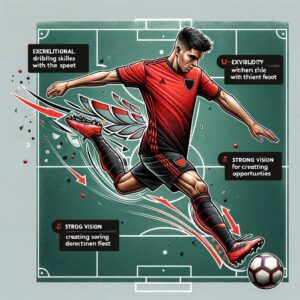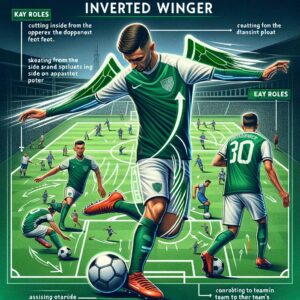The game of soccer has evolved significantly over the years, with coaches and players adopting new tactics and techniques to gain an edge. A key development in this evolution is the role of the inverted winger. This position involves a player playing on the opposite side of their dominant foot, typically a predominantly lefty on the right side of the field, or vice versa. This strategic placement allows them to cut inside towards the center, utilizing their strong foot more effectively.
In my experience, watching teams utilize the inverted winger has been a revelation in modern soccer. These players create scoring opportunities by cutting inside diagonally, disrupting traditional defensive alignments. Their movement is more lateral compared to an inside forward, which opens up space and provides opportunities to create and exploit gaps.
This role is not just about scoring; it’s about creating chances for teammates too. The dynamic nature of this position has made it an important aspect in soccer today, transforming the traditional winger into a multifaceted asset on the pitch.
What is an Inverted Winger?
The inverted winger represents a tactical evolution in soccer, a modern twist on the traditional winger role. Unlike their traditional counterparts who focus on hugging the touchline and crossing the ball into the penalty area, inverted wingers redefine the approach. Their primary task involves attacking from wide areas, but instead of sticking to the flanks, they cut inside towards the center of the field. This maneuver is not just about moving with the ball; it’s about creating space for themselves and teammates, and finding open gaps in the opposition’s defense.
The effectiveness of an inverted winger hinges on their ability to be skilled dribblers with elite-level technique. The position is unique and sets apart players who can adeptly handle the ball, especially when cutting inside against the grain of play. Being suited for this role means being responsible for not just advancing the ball but also strategically disrupting defensive alignments.
The development of this role has added a dynamic layer to soccer, making it more unpredictable and exciting. It requires players who can seamlessly transition from the periphery of the field into central, impactful positions, continually challenging the norms of how soccer is played.
Inverted Wingers vs Traditional Wingers
The choice between a traditional and inverted winger isn’t just a matter of preference but a strategic decision that can significantly influence the dynamics of a game. Knowing the difference is what all makes the goal. Below in the table, you will find out what is the difference between inverted wingers and tranditional wingers.
| Aspect | Traditional Wingers | Inverted Wingers |
| Footedness | Right-footed on right side, left-footed on left | Play on opposite side of stronger foot |
| Primary Role | Stay wide, deliver crosses into the box | Cut inside towards the center, create opportunities |
| Typical Actions | Hug the touchline, cross the ball, set up strikers | Beat defenders in tight spaces, shoot or pass |
| Skill Set | Speed, dribbling ability | Creativity, skill in tight spaces, tactical awareness |
| Defensive Handling | Outmaneuver defenders with speed | Catch defenders off guard with unpredictable movement |
| Impact on Game | Provide width, traditional crossing opportunities | Add a different dimension to attack, unpredictability |
| Game Reading | Focus on final third crosses and assists | Read the game for scoring and passing opportunities |
| Foot Usage | Stronger foot aligned with side of play | Comfortable using weaker foot for shooting or passing |
Attributes of an Inverted Winger

Inverted wingers stand out in top-flight football, thanks to their distinct attributes. They bring a unique edge to the game, capable of outmaneuvering defenders and influencing various phases of play. The prowess of an inverted winger is best understood by examining their skills across three key areas: Technical, Mental, and Physical.
Mastering the Technical Game
The Technical Attributes are fundamental. Proficiency in Crossing is essential, even from unconventional positions. Superior Dribbling skills enable them to weave through tight defenses, while excellent First Touch ensures control in high-pressure situations. Their ability to execute Long Shots and Passing makes them dual threats – able to score and assist. At the heart of these skills lies their refined Technique.
Mental Sharpness on the Field
In the realm of Mental Attributes, an inverted winger’s Anticipation is key for reading the game and finding opportunities. Composure under pressure and making the right Decisions are crucial for effective playmaking. Their Flair brings an element of unpredictability, and Vision allows them to spot and execute innovative plays. Additionally, a strong Work Rate is vital for contributing in both offensive and defensive roles.
The Physical Edge
Regarding Physical Attributes, Acceleration and Agility enable quick directional changes to evade defenders. Pace is crucial for launching counter-attacks or for defensive duties. Stamina is also critical, as these players often cover extensive areas during a match.
Role of an Inverted Winger

The role of an inverted winger in modern soccer is complex and vital. These players excel at drifting away from the sidelines, creating space for attackers to exploit. This strategic movement involves moving inside, which effectively pulls the opposition full-backs out of position, opening gaps in the defense. This not only benefits the attackers but also helps the team to overload the midfield, gaining greater control over the game. Essentially, the inverted winger acts as a hybrid between a traditional winger and a central attacking midfielder (CAM).
Unlocking Scoring Opportunities
A key role of the inverted winger is to create scoring opportunities from the wing. They often cut inside to shoot on goal with their dominant foot. The quickness and attacking mindset of these players make them incredibly valuable on a team. They are adept at taking opponents one-on-one, making crucial decisions to either pass, dribble, or shoot.
Synergy with Central Midfielders
Another important aspect of their role is linking up with central midfielders. By drifting inside, inverted wingers create beneficial passing angles for midfielders. This ability helps maintain possession of the ball and allows the team to switch play quickly from one side of the field to the other. This unpredictability is key in catching the opposition off guard and creating more chances to score.
Tactical Flexibility and Adaptation
Inverted wingers are not just players; they are tactical enigmas capable of adapting to various situations on the field. Their ability to interchange roles and fluidly move across the field makes them unpredictable and difficult for defenders to mark.
The Inverted Winger’s Impact
In summary, the inverted winger is a dynamic and versatile player, crucial for modern soccer strategies. Their unique skills in creating space, scoring, and linking play elevate their teams’ overall performance and add an unpredictable element to their attacking play.
The Inverted Winger Role in Football Manager 23
In Football Manager 23, the inverted winger plays a pivotal role that blends traditional and modern tactics. Unlike a traditional winger who sticks to the wide areas of the field, the inverted winger is positioned to capitalize on their unique ability to cut inside towards the midfield. This maneuver, executed while in possession, allows them to exploit spaces that other players might not. For instance, a left-footed player on the right wing, or a right-footed player on the left wing, uses their dominant foot to create more impactful plays.
Creating Opportunities and Delivering Precision
The primary focus of an inverted winger in the game is seeking opportunities to deliver precise crosses or dangerous through balls to strikers. This role requires a balance of vision and skill, enabling them to find and execute openings that can change the course of a match. Their strategic positioning near the 18-yard box often results in better chances to take shots at the opposition keeper.
The Subtle Contrast with Inside Forwards
In contrast to an inside forward, who primarily makes their move without the ball and aims to receive it closer to the goal, the inverted winger’s inclination to drift inwards even without the ball is a defining characteristic. Once in possession, they skillfully take on opponents, unleash shots towards the goal, and occasionally find teammates with passes. However, they do not do this as frequently as an inside forward might.
Versatility and Decision-Making
In the game, mastering the role of an inverted winger requires understanding their versatility and decision-making abilities. They are not just about taking shots; they are about seizing the right opportunity. Whether it’s finding a teammate with a well-timed pass or deciding when to challenge the goalkeeper, the inverted winger adds a dynamic layer to any team’s attack in Football Manager 23.
Famous Inverted Wingers
The role of the inverted winger has revolutionized modern football, with several players epitomizing this position through their remarkable careers.
Bukayo Saka
Bukayo Saka, currently playing for Arsenal in the English Premier League, embodies the essence of a dynamic inverted winger. A lefty, Saka has been a crucial player for both his club and England’s senior team. Known for his pace, dribbling skills, and versatility, he shines particularly during crucial times. His heatmap in the final third demonstrates significant activity in the left/central field, indicative of his effective movement and adaptability despite being in his early 20s.
Arjen Robben
Arjen Robben is often hailed as one of the greatest inverted wingers. His career spanned across top clubs like Chelsea, Real Madrid, and Bayern Munich, showcasing his explosive pace and mastery in cutting inside from the right wing onto his left foot. His trademark move of delivering a precise shot on goal became a defining element of his play. Robben was a key player for the Dutch national team, leading them to the World Cup final in 2010.
Lionel Messi
While primarily known as a false nine or central attacking midfielder, Lionel Messi, often referred to as the Goat, has also demonstrated his prowess as an inverted winger. His style, similar to Robben’s, involves a deadly cut inside from the right wing to the left foot. Messi’s incredible skill set has earned him numerous individual awards and contributed significantly to Barcelona winning La Liga and Champions League titles.
Gareth Bale
Gareth Bale, another notable name, has played for teams like Tottenham Hotspur and Real Madrid. The Welsh soccer player is renowned for his explosive pace, dribbling ability, and knack for scoring spectacular goals from long range. His versatility as an inverted winger, playing effectively on both the left and right wings, has made him a key player for the Welsh national team.
Bale’s most famous moment came in the 2014 Copa del Rey final, where he scored a stunning solo goal against Barcelona, characterized by a left-footed finish into the bottom corner of the net.
The Emerging Talents
Other emerging talents in this role include Neymar Jr., Phil Foden, and Christopher Nkunku, who continue to redefine the inverted winger position with their unique styles and contributions to the game.
Conclusion
The role of an inverted winger in modern soccer is a strategic evolution, emphasizing the use of a player’s dominant foot in the final third to effectively beat the defense. This approach, increasingly adopted by teams and advocated by youth coaches, harmonizes inverted wingers with overlapping fullbacks on the outside, thereby adding extra width and variety to attacks. This combination poses significant problems for opposing defenders and creates a spectrum of attacking threats.
Moreover, for the youth soccer player, this role is about more than just a dominant foot focus; it involves work on the less dominant leg to enhance versatility, allowing players to effectively play on both sides of the field and create opportunities for the future. This adaptability will be crucial in shaping the future of soccer, as players who can adapt to various roles will undoubtedly stand out.
Frequently Asked Questions
Is Mo Salah an Inverted Winger?
Yes, Mo Salah is an inverted winger, known for his ability to cut inside from the right wing using his stronger left foot.
Is Neymar an Inverted Winger?
Neymar has played as an inverted winger, especially when cutting inside from the left wing to utilize his dominant right foot.
Is Messi an Inverted Winger?
Lionel Messi has often played as an inverted winger, utilizing his left foot to cut inside from the right wing effectively.
What is the difference between inside forward and Inverted Winger?
The difference between an inside forward and an inverted winger is that the inside forward primarily operates closer to the goal and looks to score, whereas an inverted winger combines the roles of a winger and a midfielder, focusing on creating chances from wide positions.
What is inverted wing back?
An inverted wing-back is a player who, rather than sticking to the traditional wide defensive role, moves into central midfield areas to support possession and build-up play, effectively inverting the typical wing-back role.

